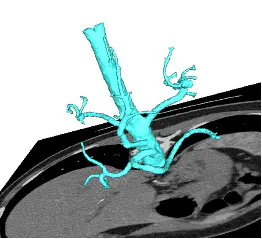Robust segmentation of anatomical structures with deformable surfaces and marching cubes

Abstract
Computer assisted medical applications require often the reconstruction of anatomical structures to compute parametershttps://vcgdata.isti.cnr.itor interventional planning. From CT and MRI datasets it is possible to obtain surface models of the organs of interest with a variety of algorithms, like Marching Cubes, level sets or deformable parametric surfaces. Each technique has advantages but also drawbacks like noise sensitivity (isosurface extraction), risk of leakages (level sets), oversmoothing and impossible handling of topological changes (Deformable models). To obtain a good trade-off between robustness, shape constraints and topological control, we propose a 3D balloon/isosurface method joining the advantages in curvature control, leakage penalization and efficiency of parametric surfaces with a fast re-parametrization handling topological changes. It is based on the control of surface self-intersections, freezing of the intersected nodes and replacement of the final mesh with an isosurface computed on a field representing the signed distance from the true surface.